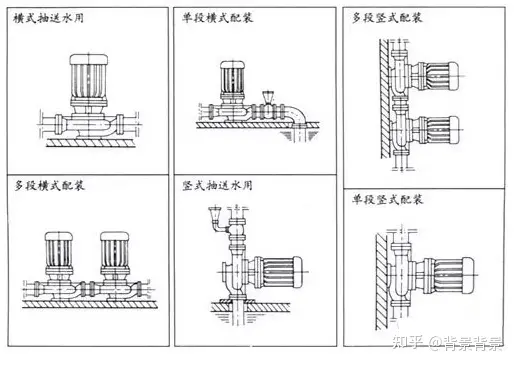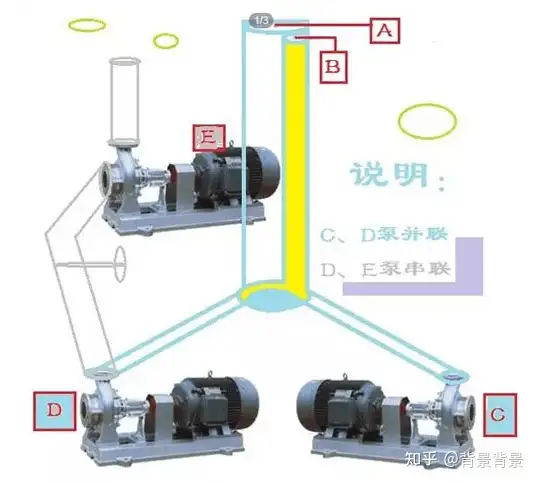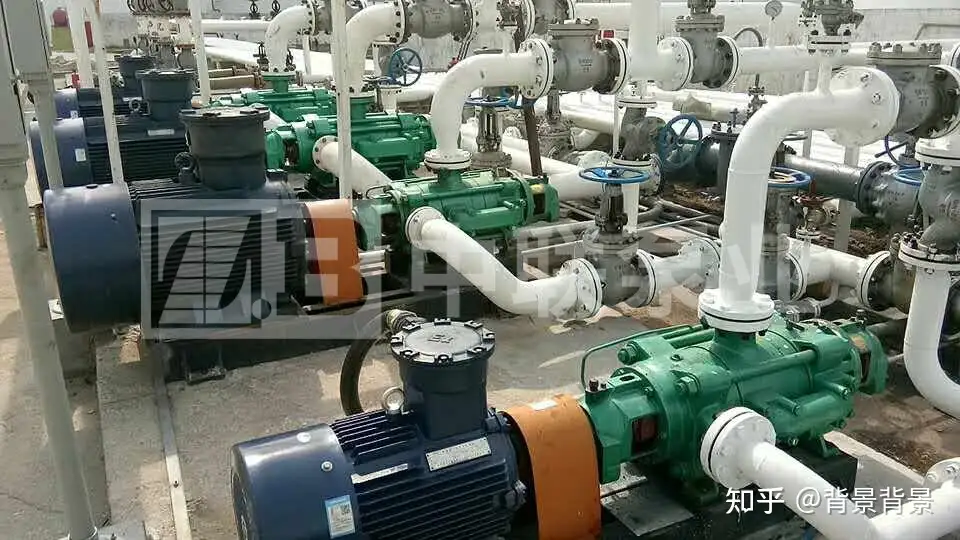- Self-balance Multistage Pump
- Horizontal Multistage Pump
- Vertical Multistage Pump
- Boiler Feed Pump
- Split Case Pump
- Single Stage Pump
- Chemical Process Pump
- Mining Pump
- Oil Pump
- Pneumatic Diaphragm Pump
- Diesel Engine Pump
- Sewage Pump
- Inline Pump
- Submersible Pump
- Condensate Pump
- Mud Pump
- Axial Flow Pump
- Mixed Flow Pump
- Fire Fighting Pump
- Vacuum Pump
- Vertical Long-shaft Pump
What is the role of series and parallel centrifugal pumps? What's the difference?
In actual use, a water treatment pump station often requires multiple centrifugal pumps to operate jointly, and the water treatment system provides the required flow and pressure, and the connection and operation modes between them are parallel and series. So what are the functions and differences of the parallel and series operation of the pump?
1、 Parallel function of centrifugal pump
The water from two or more pumps flows into a common outlet pipe, which is called the parallel operation of the pumps. In irrigation projects, water is usually taken from the same source by multiple centrifugal pumps and fed to the same irrigation system. The parallel operation of pumps means that multiple pumps share one outlet pipe. Each pump has a separate check valve. After the pump runs in parallel, the flow under the same head is added
1.1 That is: Q and =Q pump 1+Q pump 2+Q pump 3+...... +Q pump n
Centrifugal pump parallel operation features:
①The water supply can be increased, and the flow rate in the water transmission main pipe is equal to the sum of the water output of each parallel pump;
② The flow and head of the pumping station can be adjusted by opening and stopping the number of pumps to achieve the purpose of energy saving and safe water supply. For example, when the water intake pump station is designed, the flow is considered according to the maximum daily average hourly flow in the city, and the head is considered according to the low water level in the river. Therefore, in actual operation, due to the change of river level and the change of water consumption in the urban pipe network, it will certainly involve the adjustment of the opening and stopping of the intake pump station unit. In addition, it is necessary to adjust the opening and stopping of the pumping station unit;
③When one of the pumps working in parallel is damaged, the other pumps can continue to supply water, therefore, the parallel water transmission of the pump improves the flexibility of the operation of the pumping station and the reliability of the water supply, which is the most common mode of operation in the pumping station.

1.2 The parallel operation of centrifugal pumps is suitable for the following situations:
① The flow rate of a single centrifugal pump is too small to meet the needs of the irrigation system.
②When the distance of water transmission is far or the terrain conditions are complex, and the amount of soil and rock excavation of the pipeline is large, in order to reduce the investment, the water transmission pipes of multiple pumps are merged into one.
③The group well network in the northern region connects the outlet pipes of multiple pumps together to facilitate the allocation and rational utilization of water resources.
The head of the pump running in parallel should be equal or not different, it is best to use the same type of pump, and the operation management and maintenance are also convenient. If multiple pumps of the same model are connected in parallel, if the distance between the inlet pipe of each pump and the outlet junction point is short, the total flow rate after the parallel operation is equal to the sum of the flow rate of each pump, and the head remains unchanged.
2、 Series of centrifugal pump
The series operation of centrifugal pumps means that the outlet pipe of the former (first stage) pump is connected to the inlet pipe of the latter (second stage) pump, and the water is provided to the irrigation system by the last (final stage) pump. This mode of operation is suitable for the pump station with high lift, or the water transmission distance is far, the lift of a pump can not meet the requirements, and there is no suitable high lift pump. In actual use, it is rare to see three or more pumps in series, generally two pumps in series.
Centrifugal pump series mainly solve the problem of insufficient head, after the series of the pump, the flow is unchanged, the head is the sum of the two pumps. In order to avoid the downstream pump to the upstream pump water is not enough, the flow of the downstream pump is usually adjusted to the best state to ensure that the upstream pump water is sufficient. The schematic diagram is as follows:

In the figure: the outlet of the pump "D" and the inlet of the pump "E" are connected in series through pipelines. After the water pump is connected in series, the medium first enters the inlet of the pump "D", and the medium is pushed to the inlet of the pump "E" through the operation of the pump "E", the medium is transported to the place where it is needed. Pump series is essentially an extension of ladder conveying, what is ladder conveying? It means that the water level downstream is too low, and the position to be introduced is too high, and it is impossible to "complete the mission" with a pump.
For series operation, the outlet pressure of the N-1 pump (for long distance series, the loss between pumps needs to be subtracted) is the inlet pressure of the n pump, so there are certain requirements for the pressure, bearings and shaft seals of the series pumps, otherwise it will cause shell breakage, shaft seal damage, bearing heating and so on. As in the parallel case, if one or more pumps are shut down, the operating conditions of the remaining pumps will also change.
Two centrifugal pumps in series, the flow rate is best equal or not different, the head should be high and low match. The low head pump should be installed in front of the high head pump, and the low head pump should supply water to the high head pump so that the low head pump will not be able to withstand excessive pressure. If two pumps of the same model are connected in series, the pressure of the latter pump will be doubled, and the bearing capacity of the pump must be checked or pressurized. If the strength is not enough, reinforcement measures should be taken, otherwise it should not be connected in series.
If the flow of the two series pumps is different, the large flow pump should be installed in the front, by which the small flow pump water. In this way, the inlet pressure of the small flow pump is large, and cavitation can be avoided.
3、in the heating system, the role of the water pump in series and parallel and the difference
When the outlet pipe of the first centrifugal pump is connected to the suction pipe of the second pump, it is called two pumps in series. See figure (b) below. When the first pump is connected with the suction pipe of the second centrifugal pump and the outlet pipe is also connected together, the parallel operation called the pump is shown in figure (a) below.

4、 in an ideal state, the flow and head of the two pumps of the same model and specification are:
In series: Q = Q1+Q2 H = H1+H2
It is known from the above two formulas that when two or more pumps are connected in series, the flow rate does not change greatly and the head is superimposed.
In parallel: Q = Q1=Q2 H = H1=H2
That is, when two or more pumps are connected in parallel, the head of the system does not change greatly, but the flow is superimposed.
The series of centrifugal pump is often used to pressurize the water supply network, and the pump series is used in the pressure pumping station of the outdoor water supply network. Parallel pumps are often used when a single pump cannot meet the flow requirements, or when selecting a single pump with excessive system flow will cause an increase in operating costs. In parallel, the number of open pumps can be adjusted according to the amount of water consumption and the peak water consumption to reduce operating costs. In the heating system, the circulating pumps are often used in parallel to meet the flow requirements, and the standby pumps are also used in parallel.
Usually in the initial design, it is necessary to determine the flow head according to the highest water consumption and the most unfavorable point, and then determine the most economical pump number according to the flow head, at this time the flow of a single pump is: Q single =Q total ÷ number.
But there is another situation on the contrary, that is, with the performance of a single pump, to determine the operating conditions in the fixed pipeline. This is different from the above situation, it is necessary to synthesize the specific pipeline characteristic curve and the parallel post-curve of the pump at this time on a diagram to determine the working point after parallel operation.
There is a big mistake here, that is, the parallel operation flow is less than the sum of the two pumps, and this mistake is the second situation. For the flow head designed in the first case, the operating condition of a single pump is flow divided by quantity.
When communicating with customers, customers always hope that the flow rate of a single pump operating in parallel is slightly greater than the system flow divided by the number of units, which mainly depends on the design method. If it is the first system design, the selected pump will eventually run when the single pump will deviate from the working point, that is, the head is too high. If it is the second case, it is difficult to say whether it is consistent, because the curve of different manufacturers, different forms of pumps, the performance is not consistent, but it is certain that if the pipeline is determined according to the number of pumps, it is not economical.
In any case, when one or several centrifugal pumps are shut down, the working point of a single pump will change, because after the number of pumps is changed, there is a new parallel characteristic curve, and the intersection point (system working point) of the characteristic curve and the pipeline characteristic curve has significantly changed from the original working position (see the above diagram, three pumps are running in parallel, if one of them is shut down, Then the parallel flow becomes two parallel, and the operating point changes from the intersection of three parallel and the system to the intersection of two parallel and the system. At this time, the operation condition of each pump deviates from the original operation condition of three pumps in parallel, that is, it shifts to the direction of large flow; Similarly, if you increase the number of units, the situation is reversed.

